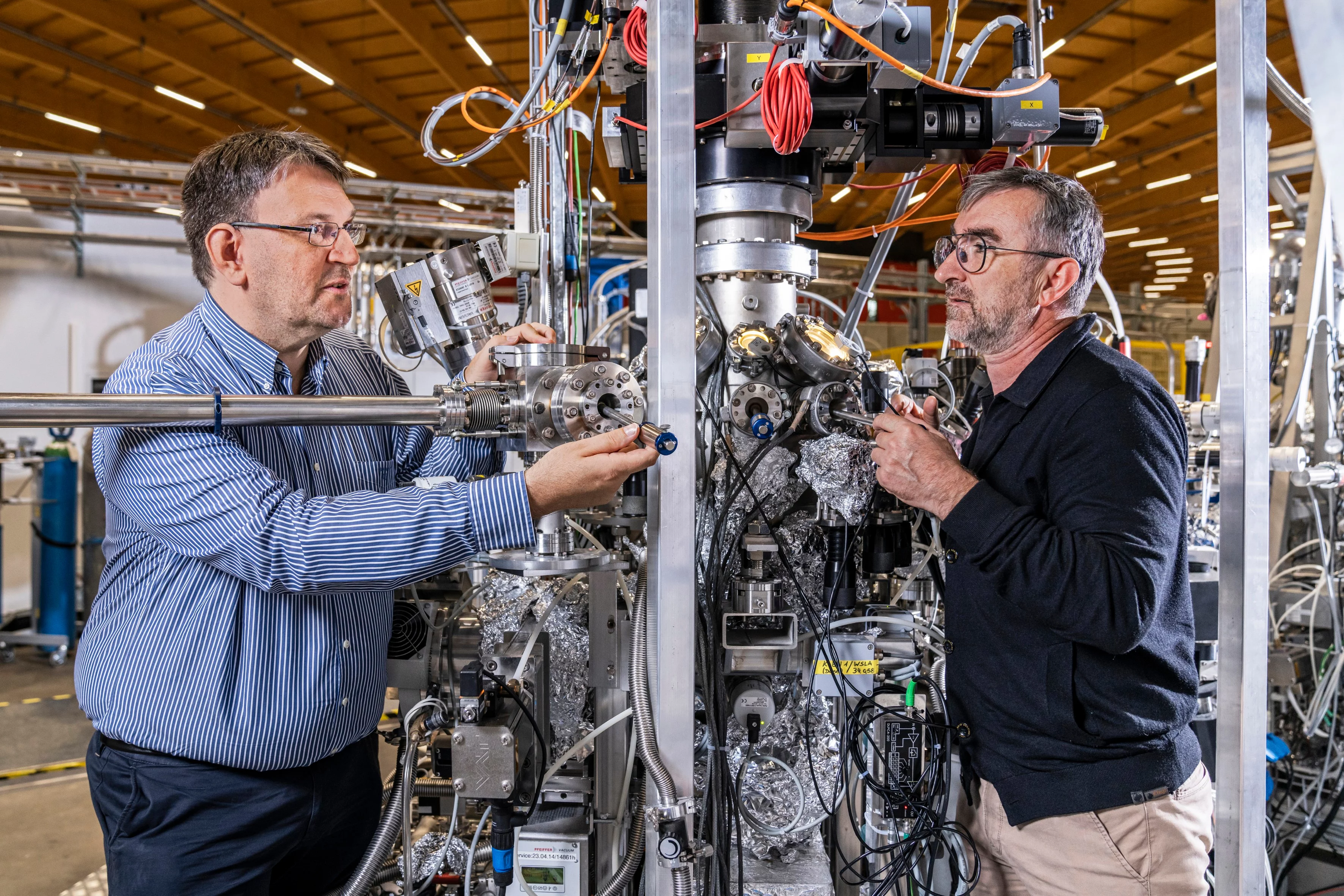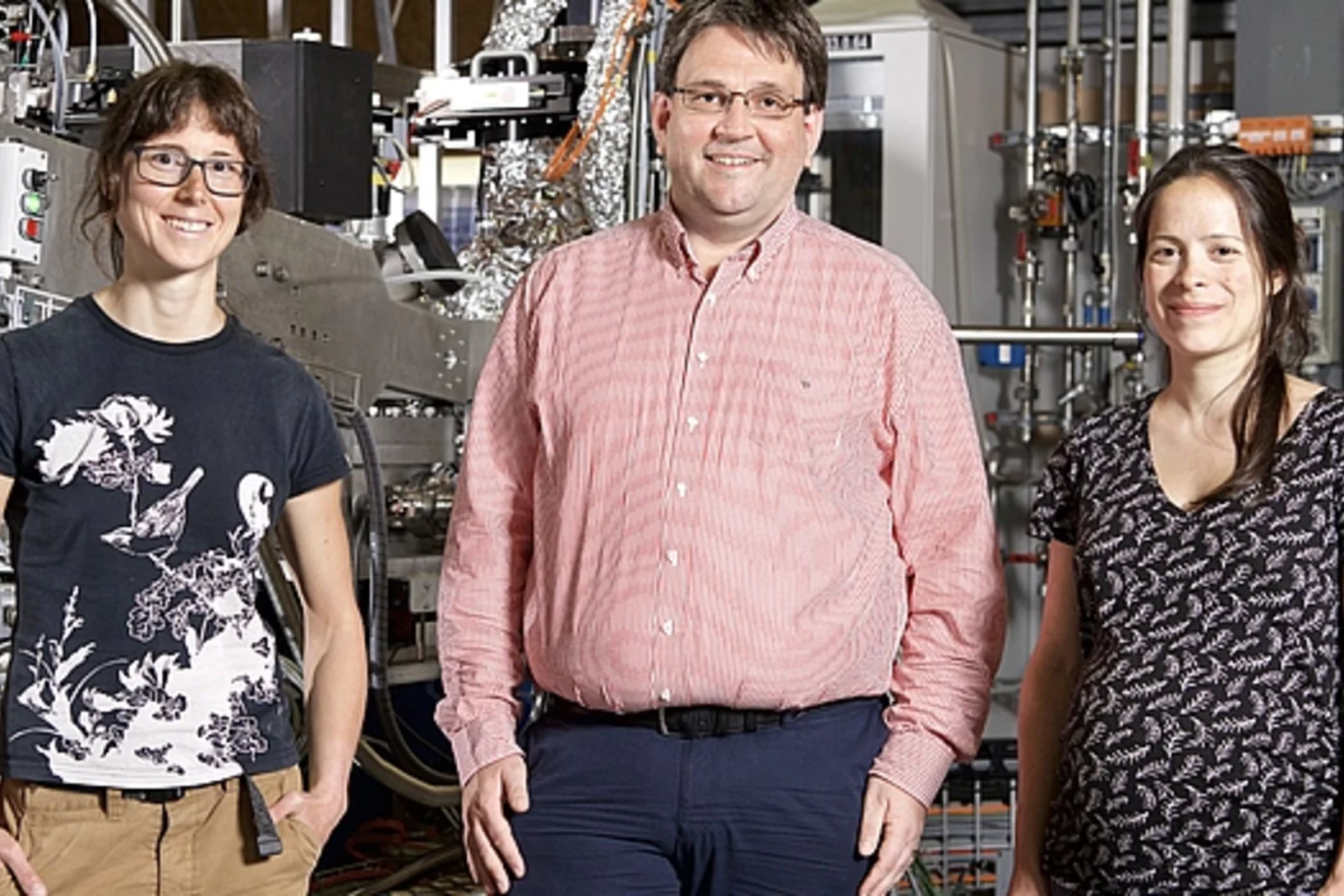PSI scientists have gained a fundamental understanding of a highly promising material that could be suited to future data storage applications. Their experiments with strontium-iridium oxide, Sr2IrO4, investigated both the magnetic and electronic properties of the material as a thin film. They also analysed how these properties can be systematically controlled by manipulating the films. This study was made possible by sophisticated X-ray scattering, a technology where PSI researchers are amongst the world experts. The results are published today in the journal Proceedings of the National Academy of Sciences.
In their quest for the magnetic data storage of the future, researchers are looking for suitable materials with properties that can be customised as flexibly as possible. One promising candidate is strontium-iridium oxide, a metal oxide with the chemical notation Sr2IrO4. PSI scientists have investigated this material, working alongside colleagues in Poland, the US and France.
"The keyword of our research is spintronics," explains Thorsten Schmitt, Head of the PSI Research Group for Spectroscopy of Novel Materials. Spintronics utilises both the electrical charge of the electron and its internal spin to develop advanced electronic components.
Spintronics is already being used in today’s hard disks, but the properties of the materials used are based on "normal" magnetism: ferromagnets such as iron or nickel where the spins are arranged in parallel. Their drawback is the relatively wide spacing required between the ferromagnetic data storage points, i.e. the bits, to prevent cross-interference. Experts believe antiferromagnetic materials could offer a promising alternative, as their spins are arranged in opposing directions. Viewed externally, antiferromagnetic materials are therefore magnetically neutral. Hence an antiferromagnetic bit would not interfere with its neighbour. "These bits can be packed more tightly together, so more data can be stored on the same space," Schmitt says. "On top of that, data read-write operations are much faster."
Strontium-iridium oxide is such an antiferromagnetic material. It is essentially a crystal within which the iridium and oxygen atoms form tinyoctahedrons. "We call this a perovskite structure," explains Milan Radovic, a physicist at PSI and co-author of the new study. "It is an ideal material for systematically manipulating its functional properties," Radovic adds.
Manipulating thin films
To perform such manipulation and discover more about the properties of this highly promising material, PSI scientists applied a thin, crystalline layer of Sr2IrO4 as the main film onto different crystalline substrates. The idea is that the substrate leads to the crystalline structure of the applied film being distorted. "It’s as if we were pulling or compressing our material at the level of the atoms," Schmitt explains. This causes the perovskite octahedrons to twist and shift slightly against each other, ultimately changing the properties of the material as a whole.
This method makes it possible to systematically fine-tune the magnetic and electronic properties of the material. And since this type of material is already being used in electronic components in the form of thin films, developing applications in this area would be the next logical step.
Obtaining a global picture
For in-depth analysis of their samples, PSI scientists used a special X-ray technique that has been heavily developed by PSI known as Resonant Inelastic X-Ray-Scattering, or RIXS for short. At PSI the researchers used soft X-rays to perform their RIXS experiments. The research in Switzerland was supplemented by additional precision measurements with hard X-rays of higher energy conducted at the European Synchrotron Radiation Facility (ESRF) in Grenoble and the Advanced Photon Source in Argonne, USA.
"Most methods focus separately on either the magnetism or the electronic properties," Schmitt explains. "With RIXS, on the other hand, we can investigate both properties with the same measurement and compare them directly with one another. In short: we have successfully obtained a global picture of our sample."
The researchers were able to discover how the electronic properties change when the crystalline lattice of the Sr2IrO4 film is distorted, and how this development is linked to the change in magnetism. Both go hand in hand – and provide important findings for potential applications.
Superconductors as a paradigm
Specifically, the group managed to modify the strontium-iridium oxide so that its magnetic properties mimic another class of fascinating materials: high-temperature superconductors composed of copper oxide layers, also known as cuprates. These also have a perovskite-like structure. In their experiment, PSI scientists pulled and twisted the Sr2IrO4 film so that the atomic distances in the crystal lattice expanded and additionally a rotation occurred. "This allowed us to make the material replicate the properties of a cuprate," says Schmitt. "However, we’re still a long way from producing a new superconductor," he says, before anyone gets their hopes up. He also thinks it may take another 10 or 20 years before the current findings will possibly contribute to the development of new data storage applications. "Our task is to produce fundamental research. This is vitally important as a stepping-stone in the future development of new materials."
Contact
Dr Thorsten Schmitt
Head of the PSI Research Group for Spectroscopy of Novel Materials,
Paul Scherrer Institute PSI
+41 56 310 37 62
thorsten.schmitt@psi.ch
[German, English]
Original publication
-
Paris E, Tseng Y, Pärschke EM, Zhang W, Upton MH, Efimenko A, et al.
Strain engineering of the charge and spin-orbital interactions in Sr2IrO4
Proceedings of the National Academy of Sciences of the United States of America PNAS. 2020; 117(40): 24764-24770. https://doi.org/10.1073/pnas.2012043117
DORA PSI
Further information
About PSI
The Paul Scherrer Institute PSI develops, builds and operates large, complex research facilities and makes them available to the national and international research community. The institute's own key research priorities are in the fields of future technologies, energy and climate, health innovation and fundamentals of nature. PSI is committed to the training of future generations. Therefore about one quarter of our staff are post-docs, post-graduates or apprentices. Altogether PSI employs 2300 people, thus being the largest research institute in Switzerland. The annual budget amounts to approximately CHF 460 million. PSI is part of the ETH Domain, with the other members being the two Swiss Federal Institutes of Technology, ETH Zurich and EPFL Lausanne, as well as Eawag (Swiss Federal Institute of Aquatic Science and Technology), Empa (Swiss Federal Laboratories for Materials Science and Technology) and WSL (Swiss Federal Institute for Forest, Snow and Landscape Research). (Last updated in June 2024)



